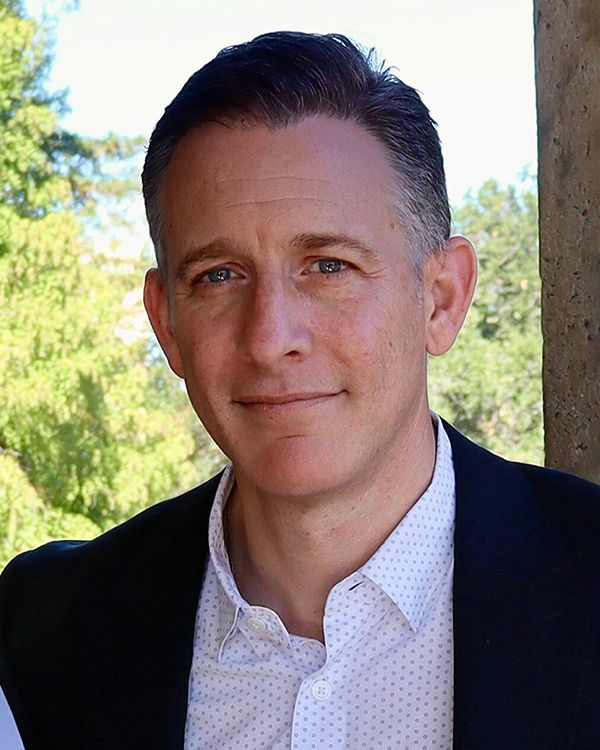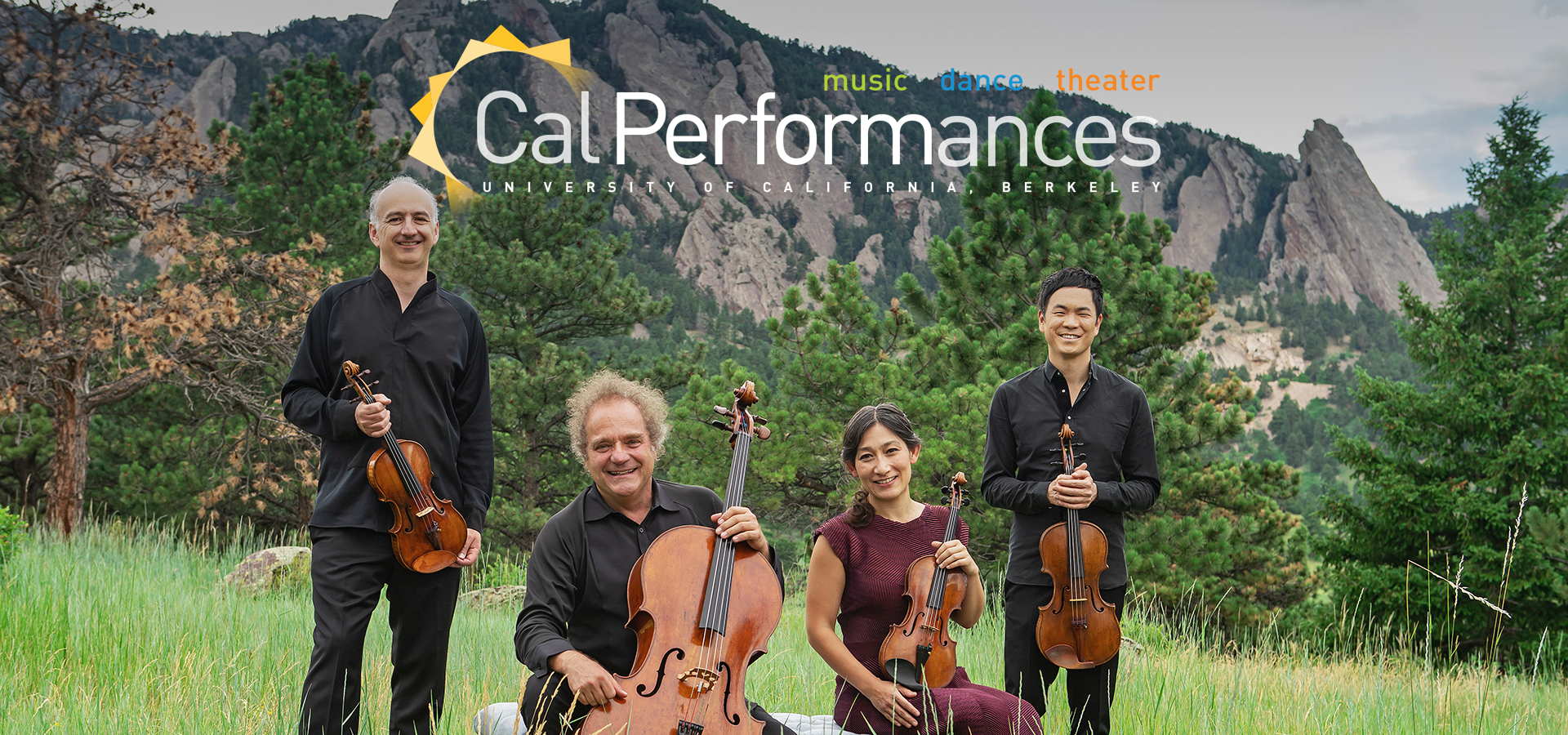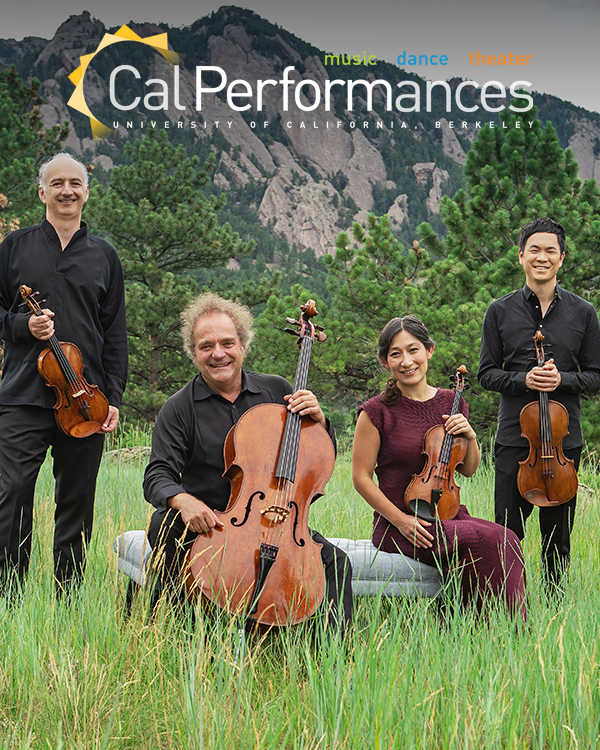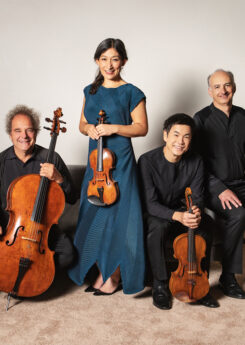Takács Quartet
Sunday, February 16, 2025, 3pm
Hertz Hall
Major support for this performance is provided by Taube Philanthropies.
The Takács Quartet appears by arrangement with Seldy Cramer Artists, and records for Hyperion and Decca/London Records.
The Takács Quartet is Quartet-in-Residence at the University of Colorado in Boulder; the members are Associate Artists at Wigmore Hall, London.
www.takacsquartet.com
From the Executive and Artistic Director

February always sees Cal Performances’ season kicking into high gear as we move into our busiest time period. Once again this year, there’s truly something for everyone as we continue with an array of events designed to appeal to the eclectic interests and adventurous sensibilities of Bay Area audiences. Together, we’ll enjoy appearances by dozens of companies, ensembles, and soloists offering a wide range of opportunities to revisit old friends as well as discover thrilling and unfamiliar performers and artworks.
At Hertz Hall (HH) this month, we begin with our annual concert by the Eco Ensemble, UC Berkeley’s acclaimed resident new-music group, performing works by alumni of the university’s prestigious composition program (Feb 1). Chamber music offerings include annual season visitors the Danish String Quartet (Feb 2); pianist Wu Han and cellist David Finckel, this year joined by guest violinist Arnaud Sussmann (Feb 9); and the Takács Quartet (Feb 16). And on February 23, we look forward to the long-anticipated return—for the first time in more than a quarter century!—of Austria’s renowned Hagen Quartet, one of the world’s most enduring and admired string ensembles.
At Zellerbach Hall (ZH), a true season highlight sees the magnificent Norwegian soprano Lise Davidsen making her Bay Area debut in recital with a great friend of our program, pianist Malcolm Martineau (Feb 4). And our world-famous dance programming is distinguished by Twyla Tharp Dance’s 60th anniversary Diamond Jubilee program (Feb 7–9), toasting the achievements that have made Tharp one of today’s most celebrated choreographers; and Batsheva Dance Company with performances of MOMO, a daring recent work by the brilliant dance maker Ohad Naharin (Feb 22–23).
Rounding out our February offerings at Zellerbach, jazz great Samara Joy demonstrates once again why she’s one of the hottest names on today’s jazz scene (Feb 5); historian and political commentator Heather Cox Richardson joins UC Berkeley professor of law and history Dylan Penningroth in a timely conversation about the reshaping of the United States’ two major political parties (Feb 26); and singer and songwriter Martha Redbone lends her soul-stirring voice to a new collaboration with her popular Martha Redbone Roots Project and the genre-defying American Patchwork Quartet (APQ) for an evening exploring the United States’ rich cultural tapestry (Feb 28).
The Redbone/APQ concert is part of our 2024–25 Illuminations theme of “Fractured History,” which continues to offer nuanced accounts and powerful new voices to enrich our understanding of the past and explore how our notions of history affect our present and future. I recommend you give particular attention to these programs, as well as check out the excellent “Fractured History” videos that live on the Illuminations page on our website; next month, for instance, sees the return of the multi-talented South African stage and visual artist William Kentridge with the Bay Area premiere of his mind-expanding new chamber opera, The Great Yes, The Great No (March 14–16, ZH). (Berkeley audiences will fondly recall the US premiere of Kentridge’s remarkable Sibyl, in addition to the many other performances and events that were part of his residency that season.)
I’m also happy to recognize the Maria Manetti Shrem and Elizabeth Segerstrom California Orchestra Residency, which this year hosts three concerts with the peerless Vienna Philharmonic and preeminent conductor Yannick Nézet-Séguin (March 5–7, ZH), and joined by pianist Yefim Bronfman for our 2025 Gala concert on March 7 (check our website for details).
Lastly, I’d be remiss if I didn’t mention another Illuminations event, the upcoming Cal Performances debut of the world-renowned Brazilian troupe Grupo Corpo (Apr 25–26, ZH). And please note that we’ve also recently added a special event to our calendar with Pultizer Prize-winning composer, vocalist, and banjo virtuoso Rhiannon Giddens and the Old Time Revue (June 21, ZH).
I look forward to engaging with so many fresh artistic perspectives alongside you as we continue with the second half of our season. Together, we will witness how these experiences can move each one of us in the profound and unpredictable ways made possible only by the live performing arts.
Jeremy Geffen
Executive and Artistic Director, Cal Performances

At Hertz Hall (HH) this month, we begin with our annual concert by the Eco Ensemble, UC Berkeley’s acclaimed resident new-music group, performing works by alumni of the university’s prestigious composition program (Feb 1). Chamber music offerings include annual season visitors the Danish String Quartet (Feb 2); pianist Wu Han and cellist David Finckel, this year joined by guest violinist Arnaud Sussmann (Feb 9); and the Takács Quartet (Feb 16). And on February 23, we look forward to the long-anticipated return—for the first time in more than a quarter century!—of Austria’s renowned Hagen Quartet, one of the world’s most enduring and admired string ensembles.
At Zellerbach Hall (ZH), a true season highlight sees the magnificent Norwegian soprano Lise Davidsen making her Bay Area debut in recital with a great friend of our program, pianist Malcolm Martineau (Feb 4). And our world-famous dance programming is distinguished by Twyla Tharp Dance’s 60th anniversary Diamond Jubilee program (Feb 7–9), toasting the achievements that have made Tharp one of today’s most celebrated choreographers; and Batsheva Dance Company with performances of MOMO, a daring recent work by the brilliant dance maker Ohad Naharin (Feb 22–23).
Rounding out our February offerings at Zellerbach, jazz great Samara Joy demonstrates once again why she’s one of the hottest names on today’s jazz scene (Feb 5); historian and political commentator Heather Cox Richardson joins UC Berkeley professor of law and history Dylan Penningroth in a timely conversation about the reshaping of the United States’ two major political parties (Feb 26); and singer and songwriter Martha Redbone lends her soul-stirring voice to a new collaboration with her popular Martha Redbone Roots Project and the genre-defying American Patchwork Quartet (APQ) for an evening exploring the United States’ rich cultural tapestry (Feb 28).
The Redbone/APQ concert is part of our 2024–25 Illuminations theme of “Fractured History,” which continues to offer nuanced accounts and powerful new voices to enrich our understanding of the past and explore how our notions of history affect our present and future. I recommend you give particular attention to these programs, as well as check out the excellent “Fractured History” videos that live on the Illuminations page on our website; next month, for instance, sees the return of the multi-talented South African stage and visual artist William Kentridge with the Bay Area premiere of his mind-expanding new chamber opera, The Great Yes, The Great No (March 14–16, ZH). (Berkeley audiences will fondly recall the US premiere of Kentridge’s remarkable Sibyl, in addition to the many other performances and events that were part of his residency that season.)
I’m also happy to recognize the Maria Manetti Shrem and Elizabeth Segerstrom California Orchestra Residency, which this year hosts three concerts with the peerless Vienna Philharmonic and preeminent conductor Yannick Nézet-Séguin (March 5–7, ZH), and joined by pianist Yefim Bronfman for our 2025 Gala concert on March 7 (check our website for details).
Lastly, I’d be remiss if I didn’t mention another Illuminations event, the upcoming Cal Performances debut of the world-renowned Brazilian troupe Grupo Corpo (Apr 25–26, ZH). And please note that we’ve also recently added a special event to our calendar with Pultizer Prize-winning composer, vocalist, and banjo virtuoso Rhiannon Giddens and the Old Time Revue (June 21, ZH).
I look forward to engaging with so many fresh artistic perspectives alongside you as we continue with the second half of our season. Together, we will witness how these experiences can move each one of us in the profound and unpredictable ways made possible only by the live performing arts.
Jeremy Geffen
Executive and Artistic Director, Cal Performances
About the Performance
Joseph Haydn
String Quartet in C major, Op. 54, No. 2, Hob. III:57
By 1788, when Haydn composed the quartet we hear this afternoon, his music and his fame had spread far beyond the Hungarian marshes and the palace of Prince Nikolaus Esterhazy, where he served as music director. Paris especially could not get enough of Haydn. In 1787, he began a set of six string quartets intended for that city’s music lovers. When he completed them the following year, he turned them over to Johann Tost, who proved the ideal agent. Tost, a virtuoso himself, was leaving his post as leader of the Esterhazy orchestra’s second violins. He was headed for Paris, where he hoped to start a new career as a soloist. Tost was a shrewd negotiator and sold Haydn’s quartets to the Paris publisher Sieber, who released the works as two sets of three, Haydn’s Opp. 54 and 55. For the obvious reason, these are called Haydn’s Tost quartets. (A third set of Tost quartets, Haydn’s Op. 64, is dedicated to the violinist.)
This C major quartet, like the Beethoven quartet that concludes this program, is filled with much that was new for its time, but in Haydn’s compact package those novelties and beauties come in inverse proportion to size. Haydn begins here with a virtuosic figure in the first violin. After pausing twice, the music continues with an abrupt key change—at about 20 seconds into the piece, this was indeed an oddity for 1788—when we’re catapulted into a bright, dancelike movement. Why that key change? Often, Haydn inserts new ideas just because he can—to show what music can do, and to keep audiences’ ears fresh.
The Adagio that follows is reflective and dirgelike, but also a showpiece for the first violin, which meanders above the dirge in a song that rises into the highest registers. Almost before we know it, the music ends, as though suspended.
The Minuet seems a conventional dance until the middle section, where we encounter a sound such as listeners in the late 18th century would not have expected, dissonant keening variants of the first section’s theme. No less expected would have been the Finale. Here audiences would have looked for fast music. What they got was an adagio, reflective and calm, then spelled briefly by a speedy presto episode before the slow music returns to close the quartet.
Benjamin Britten
String Quartet No. 2 in C major, Op. 36
Just as Beethoven revered Handel as a musical god, Benjamin Britten esteemed his 17th-century forebear Henry Purcell above all composers. In 1945, he contributed his String Quartet No. 2 to a concert commemorating the 250th anniversary of Purcell’s death. The quartet came shortly after the triumphant premiere of Britten’s opera Peter Grimes. But although the quartet is so much smaller in scale than Grimes, Britten believed it represented the greatest step forward he had yet made as a composer. “It has given me encouragement,” he said, “to continue on new lines.”
The quartet is serious and reflective, elemental stuff, perhaps a prelude to the music Britten would compose in the remaining 31 years of his life. For in work after work, he fashioned a concentrated, meditative language, deliberate and powerful and designed for journeys of probing introspection. Consider the first movement of this quartet. It is a search, the character of the music shifting constantly and abruptly, seeking solid ground, some base. Perhaps the best way to listen is to give yourself to the music, ride its current, for so emotionally charged is it that analysis fails to do it justice, let alone help the listener. In the simplest terms: Over an organ-like drone in the viola (possibly modeled on Purcell’s Fantasia Upon One Note), the other players intone a wavering theme. The pace increases suddenly, then, with an abrupt halt, the music descends into an indeterminate passage that sounds as though the instruments are tuning. From this odd texture, the first violin emerges in a variant of the opening music, introducing a tutti section. The sonic texture here is rich and varied and in a way quasi-orchestral. The texture thins. The drone-like music returns, and above this come high whoops of sound. Again the texture thickens, each player contributing turns no less disturbing or angry for the virtuosity demanded. Quiet ruminations return in an extraordinary coda that anticipates the work’s final moments, though the tranquil atmosphere here will become assertive later.
The second movement, not quite four minutes long, is something out of a fevered dream. In the pace Britten requests and in the extraordinary sounds he asks for, this music is hugely difficult to play. Commentator Roger Parker has likened it to Bernard Herrmann’s music for Hitchcock’s Psycho.
Britten called his finale Chacony, a spelling such as Purcell would have used to label a chaconne, variations over a repeated bass. The variations here are grouped into four sections, the first three sections each concluding with a solo cadenza—for cello, then viola, then first violin—and the last with a tutti coda. Roger Parker advises against trying to listen for each variant and suggests instead “listen[ing] on a larger scale to the alternations between solo passages and increasingly complicated ensemble textures.”
The movement opens with the “theme”—stated in long, slow sentences, meandering, seeking direction. Throughout the 21 variations that follow, the music is yearning, searching, ecstatic. Toward the end, tremolos in a long ethereal passage create a sense of levitation. All four members come together in a broadly melodic hymn, culminating in great slashes of C major chords, ending the work with a sense of deep fulfillment. “After the equivocation of the first movement and the eerie violence of the second movement”—Parker again—“and the stately progress of the third-movement Chacony, suddenly, and against the odds, we seem to have arrived somewhere—a victory, or perhaps a home-coming, is grandly declared.”
Ludwig van Beethoven
String Quartet in F major, Op. 59, No. 1,
Razumovsky
The Beethoven literature tends to treat his string quartets with a reverence and a solemnity that has surely scared many potential listeners. Will they grasp just what makes this most revolutionary, most serious of composers so revolutionary and so serious? Anyone nervous about getting the message can set aside those anxieties in the presence of this, the first of Beethoven’s three Razumovsky quartets. Yes, this music is revolutionary, and it’s serious. But forget that while you listen. Because this is also among Beethoven’s most exuberant, life-affirming works, the sort of thing we need especially today, at our current juncture of history.
Count Andrei Razumovsky, Russia’s ambassador to the Viennese court, was a patron of Beethoven’s. With Prince Joseph Franz von Lobkowitz, he shares the dedication of the composer’s Fifth and Sixth symphonies. He was also a musician, with chops that enabled him to play the second violin part of the three quartets he commissioned from Beethoven when they were introduced in 1807. The Razumovskys were not received well, not by the public nor by the other members of the ensemble that performed them. No quartet such as the one we hear this afternoon had been heard before, and surely not one 40 minutes long. Neither the innovations nor the length need concern us. Beethoven knew what he was up to. This was music, he told one puzzled player, “for a later age.”
That earworm of a first theme, played by cello above the pulsating strings of his partners, sings with an optimism and a nimbleness that never flags throughout this propulsive movement, whose duration seems paradoxically shorter because of how much Beethoven packs into it, how much he gives us to focus on: the ever-changing shapes of the main theme, surprises such as a recapitulation that starts but veers immediately into the development, a fugue that balances the lightness of the opening, and a sonority of almost orchestral richness. Despite what those first listeners and players thought, this is music to be enjoyed.
The scherzo—sempre scherzando, always joking—alternates between the nervous, taunting jabs of the first bars and a longer, swaying melody. What follows in the Adagio could not be a greater contrast. The long meandering melody is a lament, and Beethoven proceeds to explore its deep expressive possibilities. Some commentators have compared this music to the funeral march of the Eroica Symphony. The tragedy expressed here is on a more human level. After some 13 or 14 minutes the first violin is spotlighted in a virtuosic passage that hints at something lighter. The cello introduces a new theme that triggers the finale, a deliciously upbeat dance based on a Russian folk tune, in homage to Count Razumovsky. The spirit of the first movement returns, and again the marvel is the variety of color and texture Beethoven creates with four instruments. In the playful coda, dynamics suddenly drop and the pace slows. Then, with an outburst, the work gallops to the end.
—Larry Rothe
Larry Rothe writes about music for Cal Performances and San Francisco Opera. Visit larrytrothe.com.




